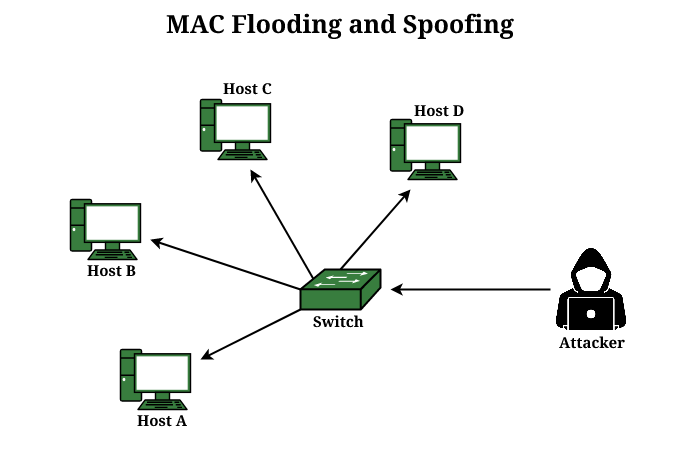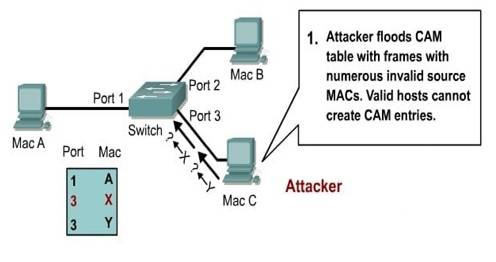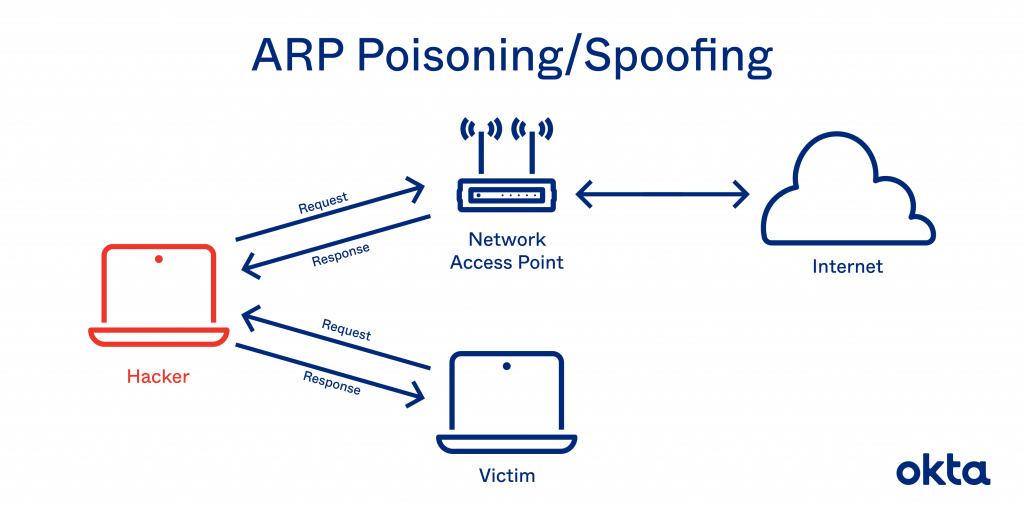What is MAC Flooding Attack? [2023]
Last updated on April 17th, 2023 in Censorship, Privacy
Last updated on April 17th, 2023 in Censorship, Privacy
 As technology evolves, so do the threats it faces. One such threat is a MAC flooding attack. This type of cyber-attack can be devastating for networks and result in significant downtime or even data breaches.
As technology evolves, so do the threats it faces. One such threat is a MAC flooding attack. This type of cyber-attack can be devastating for networks and result in significant downtime or even data breaches.
In this blog post, we will explore what a MAC flooding attack is, how it works, the pros and cons of using it, and finally how to prevent it from happening to your network.
So buckle up and let’s dive into the world of MAC flooding attacks!
A MAC flooding attack is a type of cyber-attack in which an attacker floods the switch’s CAM table with fake MAC addresses. The CAM table maintains a list of connected devices and their corresponding MAC addresses.
When the limit is exceeded, the switch moves into fail-open mode and starts broadcasting all incoming packets to all ports.
The goal of this attack is to overload the switch’s capacity by filling up its CAM table, causing it to operate slowly or become unresponsive. Once overloaded, attackers can then launch other forms of attacks like man-in-the-middle (MITM) attacks or data interception.
One critical thing to note about MAC flooding attacks is that they are not limited only to switches. Routers and firewalls can also fall victim if they have insufficient memory resources.
Understanding what a MAC flooding attack entails it’s very important. It will help you take the necessary steps towards securing your network against these types of cybersecurity threats.
 MAC Flooding Attack is a type of cyber attack that exploits the weakness in the way switches handle MAC addresses. In this kind of attack, an attacker floods a switch with fake MAC address frames to overload its memory capacity.
MAC Flooding Attack is a type of cyber attack that exploits the weakness in the way switches handle MAC addresses. In this kind of attack, an attacker floods a switch with fake MAC address frames to overload its memory capacity.
The switch then enters into a state where it cannot differentiate between real and fake MAC addresses. This results in accepting all traffic without verifying the source.
This allows attackers to intercept sensitive information as they can now access data packets meant for other devices connected to the same network.
MAC Flooding Attacks are executed through sophisticated tools like Cain and Abel or Ettercap. They enable hackers to send high volumes of spoofed data frames within seconds.
This method makes it difficult for network administrators to detect such attacks as there’s no clear indication of malicious activity on their end. Additionally, these attacks aren’t limited by geographical location. Anyone with an internet connection can launch them from anywhere in the world.
It’s important to take measures against this type of attack because once attackers gain unauthorized access. They could cause severe damage by stealing confidential data or installing malware on your system.
 MAC Flooding Attack is a technique used by attackers to overwhelm the switch’s CAM table with fake MAC addresses, causing it to flood all incoming data packets. While this attack can be effective for disrupting network communication it comes with its own set of pros and cons.
MAC Flooding Attack is a technique used by attackers to overwhelm the switch’s CAM table with fake MAC addresses, causing it to flood all incoming data packets. While this attack can be effective for disrupting network communication it comes with its own set of pros and cons.
One benefit of using MAC Flooding Attack is that it can render the entire network unusable without requiring extensive technical knowledge or resources. It is also difficult to detect as there are no payloads in the packets generated during this type of attack.
On the downside, however, MAC Flooding Attack does not provide complete control over targeted devices since only their connectivity will be affected. Moreover, flooding attacks require high bandwidth consumption which could result in network slowdowns.
Another disadvantage of using a MAC Flooding Attack is that an attacker may need multiple machines. They are used to execute such an attack successfully on larger networks effectively. Besides these limitations mentioned above.
It’s worth noting that performing a flooding attack on someone else’s system without permission constitutes illegal hacking under most jurisdictions’ cyber laws.
While MAC Flooding Attacks have some benefits when deployed strategically for certain purposes; they come at a cost and should only be used ethically and within legal boundaries.

MAC flooding and ARP poisoning are two distinct types of attacks, but they share some similarities. Both MAC flooding and ARP poisoning target the network layer of a computer system. However, there are some key differences between them.
MAC flooding is a type of attack that floods the switch with an overwhelming number of fake MAC addresses until it reaches its limit. Once this happens, the switch becomes unable to function properly. It also begins broadcasting all traffic to all connected devices in what’s known as a “broadcast storm.”
This can lead to enormous amounts of traffic on a network and ultimately cause it to crash.
On the other hand, ARP poisoning involves sending fake Address Resolution Protocol (ARP) messages onto a local area network in order to associate attacker’s MAC address with IP address belonging to another device on the same network.
The result is that all data destined for that IP address will be sent instead to the attacker’s machine.
While both attacks have similar effects on networks – causing them slow down or crash altogether – they work differently. Understanding these differences can help organizations take steps towards securing their networks against these kinds of threats.
Preventing a MAC flooding attack requires implementing proper security measures. One effective way to prevent this type of attack is by setting up port security on network switches. This feature allows you to limit the number of MAC addresses that can be learned and stored on each switch port.
Additionally, configuring network devices with static ARP tables can help prevent MAC flooding attacks. By defining the mapping between IP addresses and MAC addresses in advance, attackers will not be able to modify these mappings through ARP spoofing methods.
Another essential step in preventing MAC flooding attacks is to keep your software up-to-date. Network devices such as routers and switches should have the latest firmware versions installed, which often include security updates.
It’s always a good idea to monitor your network regularly for any unusual traffic patterns or signs of potential attacks.
Setting up intrusion detection systems (IDS) or intrusion prevention systems (IPS) can help detect and mitigate potential threats before they cause significant damage.
By taking these preventive measures, you’ll significantly reduce the risk of falling victim to a devastating MAC flooding attack.
MAC flooding attack is a serious threat to network security that can cause significant damage. It exploits the weakness in how switches forward traffic on local area networks by overflowing the switch’s CAM table with fake MAC addresses.
This leads to a denial of service and potentially exposes sensitive information.
While there are some advantages to using this type of attack, such as being able to bypass security measures put in place by network administrators. It is important for businesses and organizations to take the necessary steps to prevent these attacks from happening.
Preventative measures can help mitigate the risks associated with MAC flooding attacks. Such examples are implementing port security features on switches, enabling dynamic ARP inspection, and monitoring network traffic.
By staying informed about potential threats like this one and taking proactive steps towards securing their infrastructure, businesses can ensure that their networks remain safe and secure now and into the future.